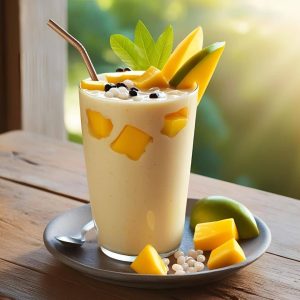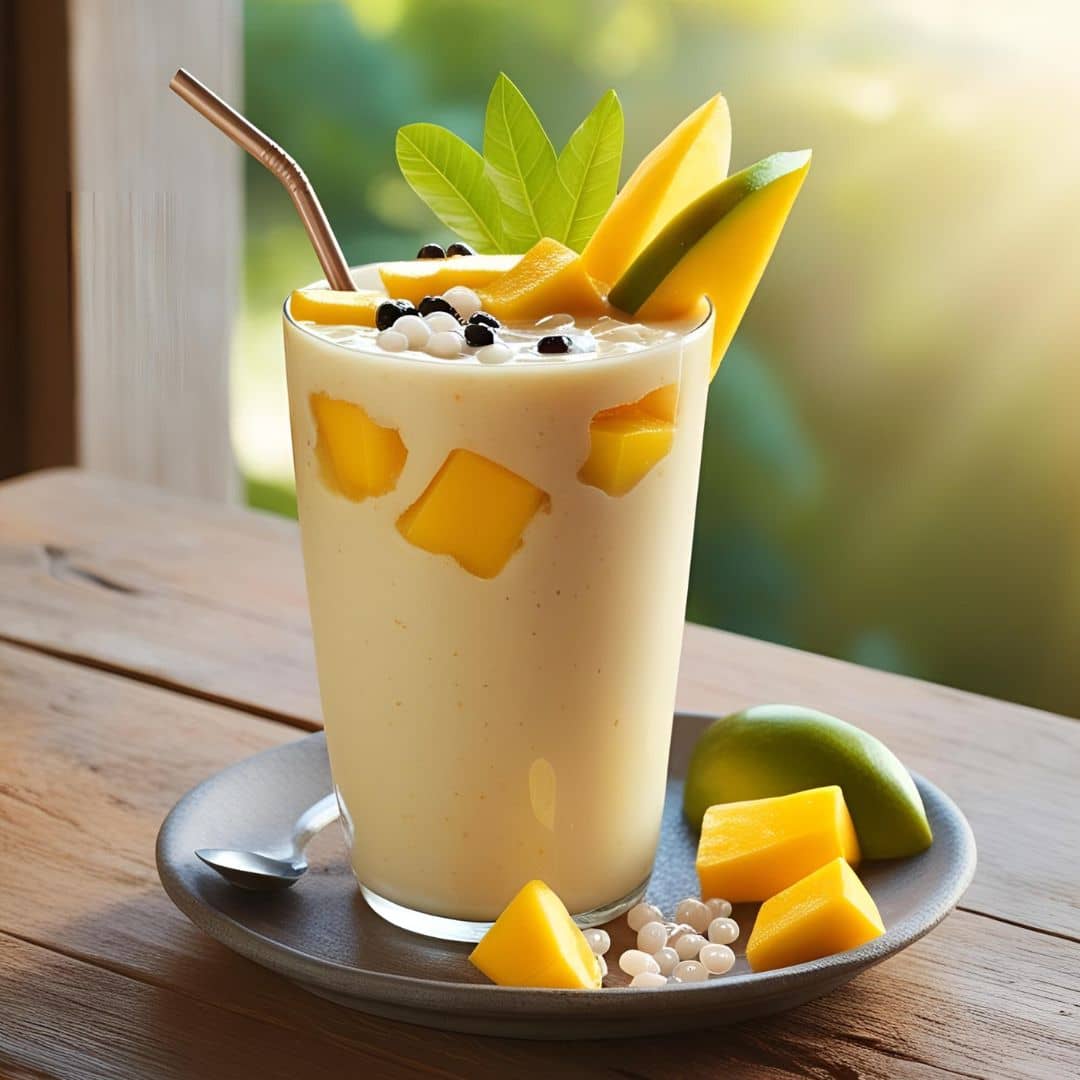Introduction
Mango Sago is a refreshing and delightful dessert that combines the creamy richness of coconut milk with the juicy sweetness of ripe mangoes, complemented by the chewy texture of sago pearls. Originating from Southeast Asia, particularly popular in Hong Kong, Singapore, and Malaysia, Mango Sago has become a beloved treat across the globe. Its vibrant color, tantalizing taste, and simple preparation make it a favorite for both casual family meals and festive gatherings.
The History of Mango Sago
Mango Sago is believed to have been created in Hong Kong during the 1980s by innovative chefs who sought to blend traditional Chinese dessert elements with tropical fruits. The dessert gained rapid popularity due to its refreshing taste, especially suitable for hot climates. Its influence spread quickly to neighboring countries and eventually to Western countries, where it became a staple in Asian dessert menus. The combination of tropical mangoes with sago pearls and coconut milk reflects the rich cultural tapestry of Southeast Asian cuisine, where local ingredients and culinary traditions intermingle.
Ingredients Breakdown
- Mangoes: The star ingredient, preferably ripe and sweet varieties like Alphonso, Ataulfo, or Honey mangoes for a rich flavor and vibrant color.
- Sago Pearls: Small, chewy tapioca pearls that add texture and contrast to the smooth mango puree.
- Coconut Milk: Provides a creamy, aromatic base that complements the tropical flavor of mangoes.
- Sugar: Adjusted to taste, depending on the sweetness of the mangoes.
- Water: Used to cook the sago pearls.
- Evaporated Milk or Condensed Milk (Optional): For added creaminess and a richer taste.
- Ice Cubes or Chilled Water: To serve the dessert cold, enhancing its refreshing quality.
Step-by-Step Recipe
- Prepare the Sago Pearls:
- Bring a pot of water to a boil.
- Add the sago pearls, stirring occasionally to prevent sticking.
- Boil for about 10-15 minutes until the pearls become translucent, with a small white dot in the center.
- Remove from heat, cover the pot, and let sit for an additional 5-10 minutes until fully translucent.
- Rinse the cooked sago under cold running water to remove excess starch and prevent clumping. Drain well.
- Prepare the Mango Puree:
- Peel and dice the mangoes, reserving some cubes for garnish.
- Blend the diced mango with a small amount of water or coconut milk until smooth.
- Combine the Ingredients:
- In a large bowl, mix the mango puree with coconut milk. Adjust the thickness by adding more coconut milk or water as needed.
- Add sugar to taste, stirring until fully dissolved.
- Fold in the cooked and drained sago pearls.
- Chill and Serve:
- Refrigerate the mixture for at least 1-2 hours to enhance the flavors.
- Serve chilled, garnished with fresh mango cubes and a drizzle of coconut milk or condensed milk for extra creaminess.
Tips
- Use fully ripe mangoes for natural sweetness and vibrant color.
- Rinse sago pearls thoroughly after cooking to prevent stickiness.
- Adjust the sweetness according to the mango’s natural sugar content.
- Add a dash of lime juice to enhance the tropical flavor.
- For a thicker consistency, reduce the amount of liquid or use coconut cream instead of coconut milk.
Variations and Customizations
- Mango Pomelo Sago: Add pomelo pulp for a citrusy, slightly bitter contrast.
- Vegan Version: Use plant-based milk alternatives like almond or oat milk instead of evaporated milk.
- Layered Dessert: Create layers of mango puree, sago mixture, and diced fruits for a visually appealing presentation.
- Fruit Variations: Substitute or mix mango with other tropical fruits like papaya, passion fruit, or lychee.
- Spiced Mango Sago: Add a hint of cardamom or ginger for an exotic twist.
Health Considerations and Nutritional Value
Mango Sago is a delightful treat, but like many desserts, it should be enjoyed in moderation:
- Calories: Mangoes and coconut milk are calorie-dense; opt for light coconut milk if you’re calorie-conscious.
- Sugars: Adjust added sugar based on the mango’s natural sweetness to reduce overall sugar intake.
- Fiber and Vitamins: Mangoes are rich in vitamin C, vitamin A, and dietary fiber, contributing to overall health.
- Gluten-Free: Naturally gluten-free, making it suitable for individuals with gluten sensitivities.
- Dairy-Free: Easily adaptable for dairy-free diets by using plant-based milk options.
FAQ
- Can I make Mango Sago ahead of time? Yes, Mango Sago can be prepared a day in advance. Just keep it refrigerated and add fresh mango cubes before serving.
- How long does Mango Sago last in the fridge? It can be stored in an airtight container in the refrigerator for up to 2-3 days.
- Can I freeze Mango Sago? Freezing is not recommended as it may alter the texture of the sago pearls and mango puree.
- What if I can’t find sago pearls? You can substitute with small tapioca pearls, but the texture will be slightly different.
- Is Mango Sago healthy? While it contains nutritious mangoes, it can be high in sugar and calories. Moderation is key.

Mango Sago
Ingredients
- Mangoes: The star ingredient preferably ripe and sweet varieties like Alphonso, Ataulfo, or Honey mangoes for a rich flavor and vibrant color.
- Sago Pearls: Small chewy tapioca pearls that add texture and contrast to the smooth mango puree.
- Coconut Milk: Provides a creamy aromatic base that complements the tropical flavor of mangoes.
- Sugar: Adjusted to taste depending on the sweetness of the mangoes.
- Water: Used to cook the sago pearls.
- Evaporated Milk or Condensed Milk Optional: For added creaminess and a richer taste.
- Ice Cubes or Chilled Water: To serve the dessert cold enhancing its refreshing quality.
Instructions
Prepare the Sago Pearls:
- Bring a pot of water to a boil.
- Add the sago pearls, stirring occasionally to prevent sticking.
- Boil for about 10-15 minutes until the pearls become translucent, with a small white dot in the center.
- Remove from heat, cover the pot, and let sit for an additional 5-10 minutes until fully translucent.
- Rinse the cooked sago under cold running water to remove excess starch and prevent clumping. Drain well.
Prepare the Mango Puree:
- Peel and dice the mangoes, reserving some cubes for garnish.
- Blend the diced mango with a small amount of water or coconut milk until smooth.
Combine the Ingredients:
- In a large bowl, mix the mango puree with coconut milk. Adjust the thickness by adding more coconut milk or water as needed.
- Add sugar to taste, stirring until fully dissolved.
- Fold in the cooked and drained sago pearls.
Chill and Serve:
- Refrigerate the mixture for at least 1-2 hours to enhance the flavors.
- Serve chilled, garnished with fresh mango cubes and a drizzle of coconut milk or condensed milk for extra creaminess.
Notes
- Use fully ripe mangoes for natural sweetness and vibrant color.
- Rinse sago pearls thoroughly after cooking to prevent stickiness.
- Adjust the sweetness according to the mango’s natural sugar content.
- Add a dash of lime juice to enhance the tropical flavor.
- For a thicker consistency, reduce the amount of liquid or use coconut cream instead of coconut milk.

